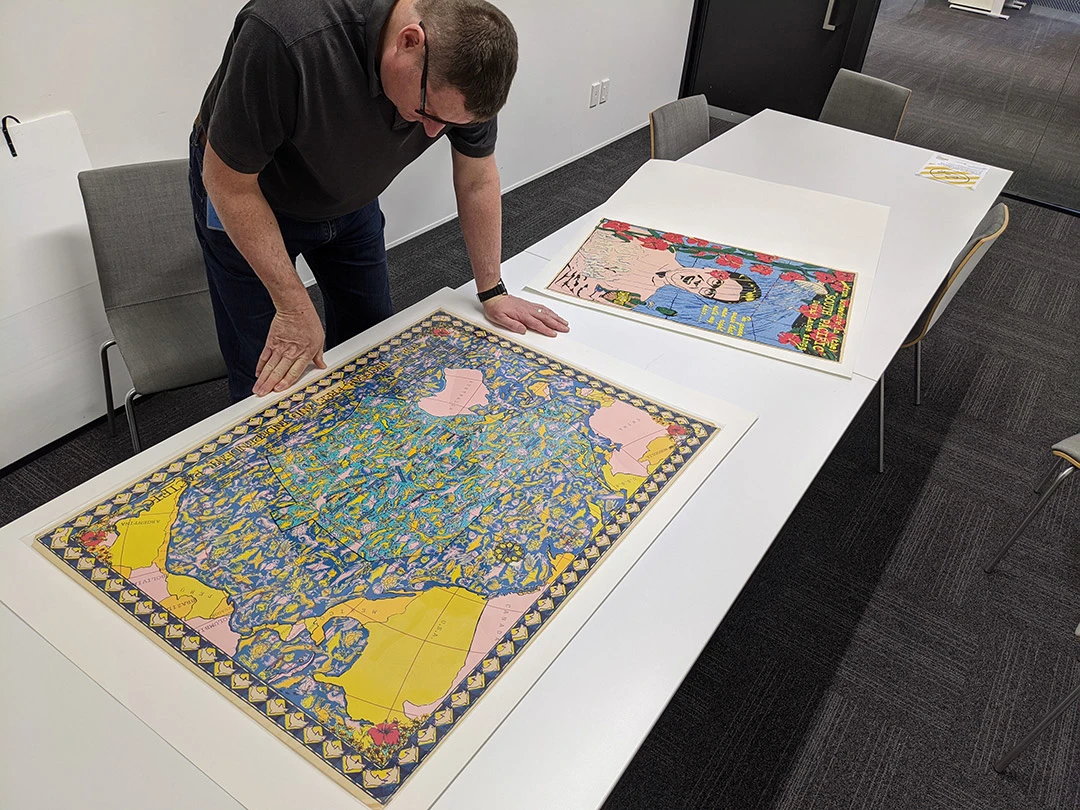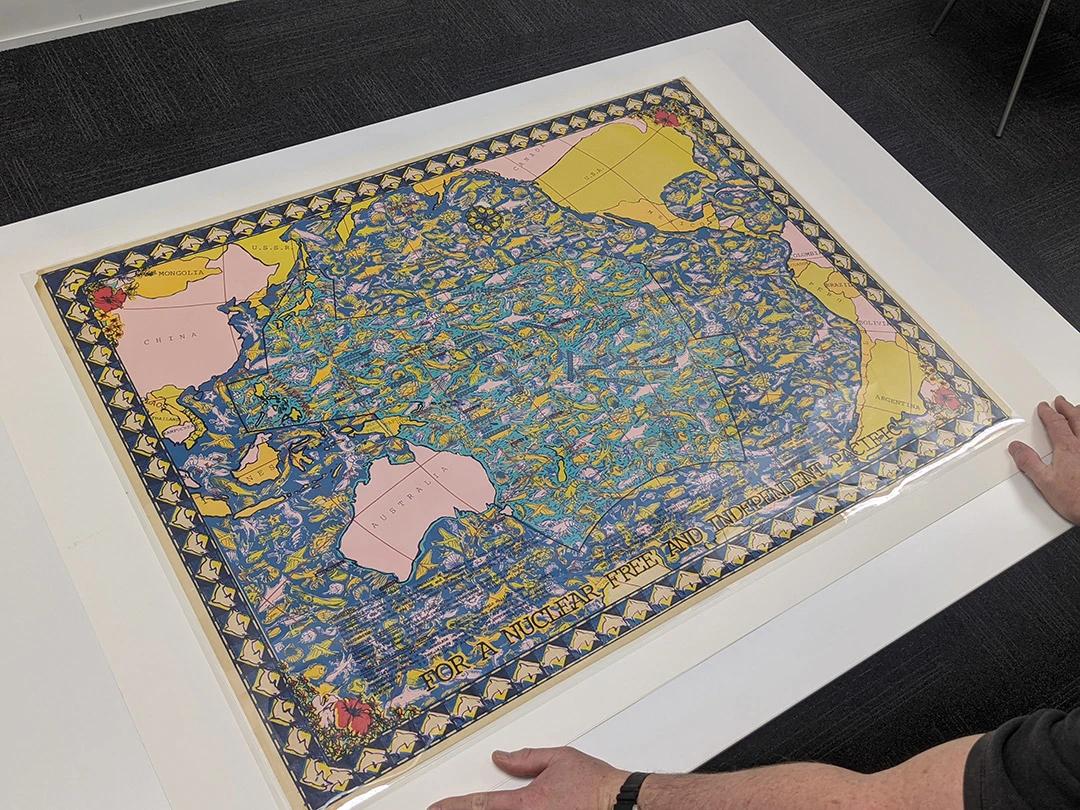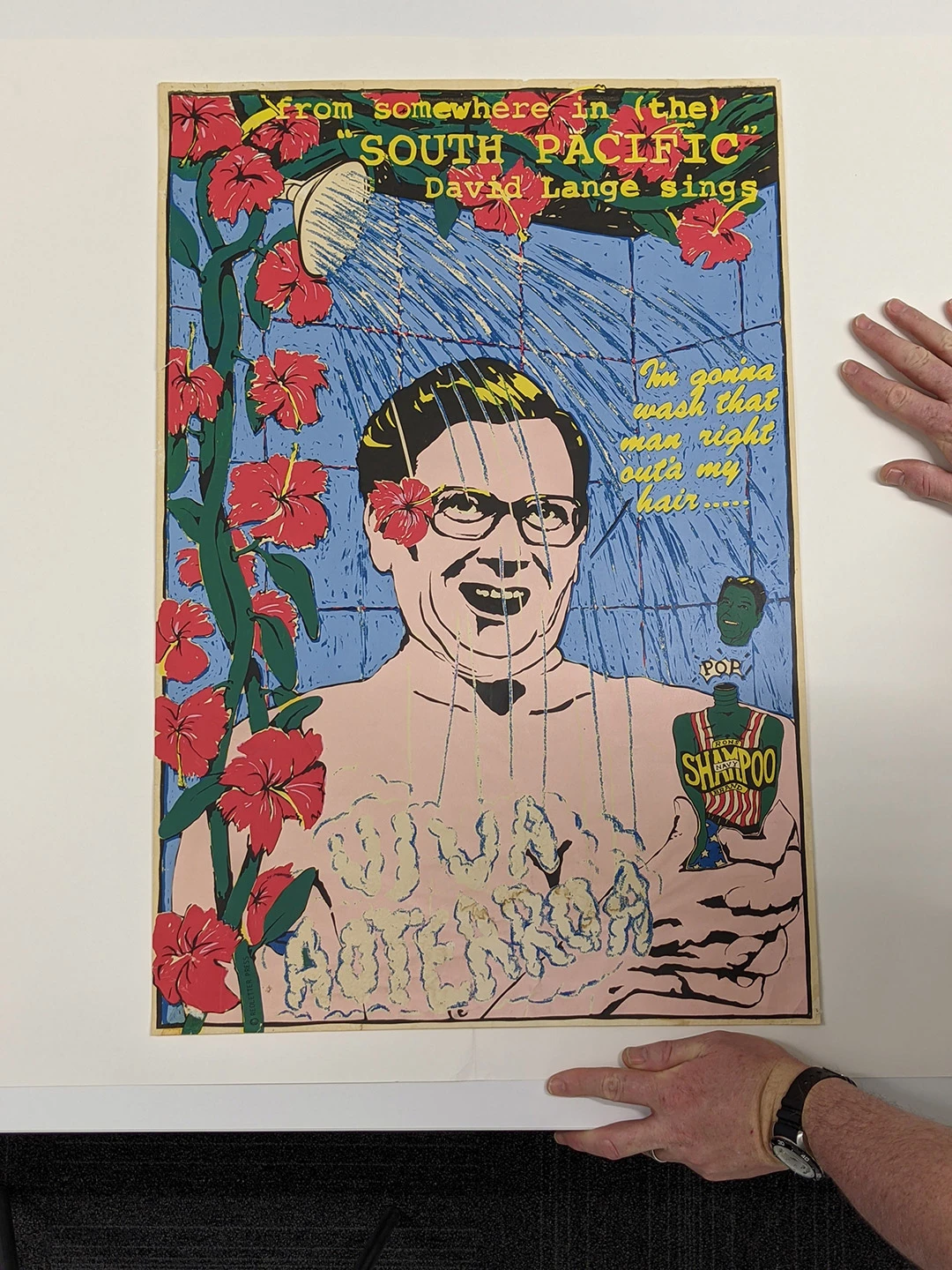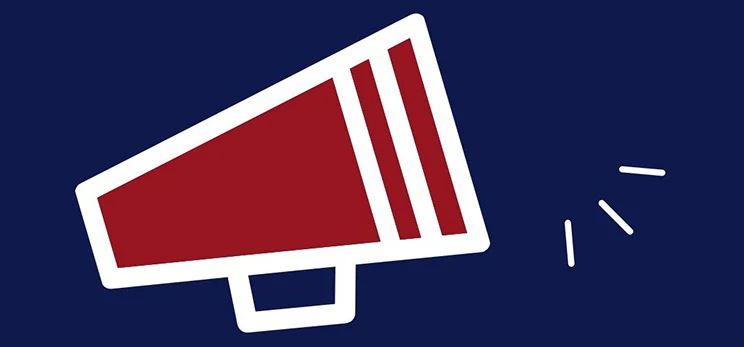Ep.2 Protesting in the shower
Barbara Lyon, recently retired Ephemera Curator, talks to us about a couple of beautiful anti-nuclear protest posters from the 1980s.
Protesting in the shower
David Lange singing in the shower and a gorgeous poster of a proposed nuclear-free zone are two of the over 200,000 ephemera items dating from the 1840s to the present in the Ephemera Collection.
Transcript
Speakers
Mary Hay, Seán McMahon, Barbara Lyon
Mary Hay: Kia ora and welcome to The Library Loudhailer, the monthly podcast of the National Library of New Zealand Te Puna Mātauranga o Aotearoa My name is Mary Hay and together with Sean McMahon we'll be sharing some of the unique voices and stories from our library staff and collections.
Seán McMahon: Today, Mary is talking with Barbara Lyon, the recently retired Ephemera Curator from the Alexander Turnbull Library. This interview was recorded earlier this year, but the broadcast has been delayed due to the COVID-19 lockdown.
And now, let's join Mary and Barbara and the large format collection stacks as they look at some protest posters from the 1980s.
Mary Hay: I'm with Barbara Lyon, curator of the Ephemera Collection at the Alexander Turnbull Library. Now what are we looking at here, Barbara? What have you chosen from the Ephemera Collection to share with us?
Barbara Lyon: What I have chosen is something that's fairly recent in terms of the Ephemera Collection. It's from 1985.
It's a protest poster, and it's called for a nuclear free and independent Pacific. It was printed in Australia actually, by an artist called Mark Denton of the Red Letter Press, but it's the most glorious poster.
It's over a meter wide, it's got a horizontal orientation, and it shows a map of the Pacific Ocean absolutely teeming with fish and other sea creatures.
And what the poster is proposing is a particular zone, which includes New Zealand, all the Pacific Islands, the Philippines, and Japan, and it's suggesting a nuclear free zone in that area.
Mary Hay: And where would this poster ... what was the point of the poster what would have been done with it?
Barbara Lyon: Well, it was a protest poster, and so typical of a lot of things that were coming out in the 1970s and 1980s, when people really started the trend of using posters to make their point, their protest point, but this would have actually been part of a tradition of print makers in Australia, near Melbourne.
This poster was made at about the time when New Zealand became very involved with the anti-nuclear movement, and actually became quite a leader in the anti-nuclear movement.
The Red Letter Press put out to a poster at about the same time showing David Lange singing in the shower. It's a kind of anti-American protest. If you recall, David Lange was involved in the Oxford Union Debate, where he championed the cause of non-nuclear testing in the Pacific.
Mary Hay: So we've also got that David Lange poster here as well, haven't we? And it's showing David Lange in the shower with a hibiscus tucked behind his ear. There's hibiscus all up the left hand side of the poster, and then he's also holding, what's that that he's holding?
Barbara Lyon: He's holding a shampoo bottle that's got a top on it with Ronald Reagan's head, and it's called Ron Shampoo, I think. It's making a play on a song from the musical ‘South Pacific’ from the 1950s. And so David Lange is singing a song from that musical, ‘I'm Gonna Wash That Man Right Outa My Hair’.
Mary Hay: So it's the idea of getting rid of the Americans out of the South Pacific, is that what was happening here?
Barbara Lyon: I think so, yes. Well, you know, I think that at this time we kind of blotted our copybook as far as ANZUS was concerned, and so because of the nuclear question. And we were left out of agreements with Australia and the US after that for some years.
Mary Hay: So these two posters are like a pair, are they? Were they around the same time, the posters?
Barbara Lyon: They were around the same time and produced by the same printing press, and they've both got hibiscus on them and yes, they probably were a pair to some extent, and there may have been others in the same series. They're not the same format, of course. One is horizontal orientation and one's portrait orientation.
Mary Hay: So at the time that they were made where would they have been used or hung?
Barbara Lyon: I imagine they would have been made in quite limited quantities, because of the richness of the materials used and they're quite large. So I don't imagine that they would have been hung in the streets, necessarily. They're not that sort of thing you can just slap up in the street.
Well, they are part of a big tradition of protest posters from the 1980s, but also we've got a strong collection of anti-nuclear posters from that era. These would be some of the more beautiful and beautifully produced ones.
As you can imagine, there are some that get put up by small fly-by-night groups that are quite roughly made, because from the 1970s onward, it became much cheaper just to manufacture your own posters and get them put up around town.
Mary Hay: I'm really interested in understanding what is ephemera and what's the function of ephemera?
Barbara Lyon: Yes. OK, well, when we're talking about protest posters in the Ephemera Collection, that just illustrates one of the quite exciting aspects of the Ephemera Collection.
Now ephemera, meaning relating to the day, is a Greek term, and I quite like the story of Aristotle naming a mayfly an ephemeron. Now, a mayfly lives for just one day, and within that day it's got to carry out the purpose for which it was created.
So Ephemera is somewhat similar, in that it's produced just to have an effect at the time and then is usually disposed of. But luckily the library has kept quite a lot of material that's made for that purpose.
Protest posters are quite important, because actually you can think of them as primary source material. They actually played a part in the formation of the history of our country, so they're active, played an active role. In some ways they're a witness to things that were going on as well.
Mary Hay: Yeah that's really, really useful way to understand it. I think you've also talked about how you've got the archaeological midden? Can you talk a bit more about that?
Barbara Lyon: When I first started in the Ephemera Collection, that's the way I thought of it, first of all, was that it's all rubbish that's been thrown away. And so in that way it's quite like an archaeological midden, where archaeologists can go in and look at the rubbish that people have thrown away to get a reflection of what the society was really like.
So the Ephemera Collection is a wee bit like that. And so you can dig through, you can have a look through restaurant menus or greeting cards or tickets, show programmes, all that sort of thing and just get some idea of the minutia of what was going on in everyday life.
One of the things I quite liked from about 10 years ago, I remember, was a map of a supermarket, and it was a guide to show people how to get around the supermarket. But one of the things on it was a natural food and gluten-free section, and I thought that's really interesting to show people in the future when we first started having a gluten-free section within a supermarket. I mean, it probably happened around about 10 years ago.
Mary Hay: That's right, and also I think with a midden, you can see what people were actually like, not what they wanted you to think they were like.
Barbara Lyon: Yes, yes. There was no thought about how posterity would see us.
Mary Hay: What is the interest of these posters for researchers?
Barbara Lyon: Researchers and thesis writers and book writers are always looking for new angles about New Zealand history, so if they were looking to write about protest movements in New Zealand, or specifically the anti-nuclear protests, or if they were looking at the history of screen printing, these would be great examples to show them.
Of course, these are just the tip of the iceberg, as I say, there is a lot more to do with the anti-nuclear movement and protest movements in New Zealand, and it would be quite interesting to see the different kinds of media that have been used.
Some have just been photocopies, even, that can be produced very quickly and cheaply and stuck up in great numbers around town. Some have been relief prints or linocuts or that sort of thing. So you know, they're all interesting and they all have their own textures, which make them quite appealing.
Mary Hay: Yeah, what's the texture of these ones? What's the media that they're printed on?
Barbara Lyon: Well, they're screen prints, so they would be made by a series of different colored inks being put on progressively to build up the different colors that are showing there.
Mary Hay: There would have been a lot of layers, I mean on this one, with all the map.
Barbara Lyon: Yes, yeah, what there would be sort of seven or eight colors there, I think.
Mary Hay: So how does Ephemera come into the collection at the Library?
Barbara Lyon: Well, it comes in by a couple of different ways. Most of the collection has come in via donation, but we do have a small budget for purchasing things from dealers or from auctions or from individuals. When people offer us material, we have a look to see, you know, does it fit the collection policy? The collection policies are all shown on the National Library website, if people wanted to go and check there. So the Ephemera Collection has things that relate to New Zealand or New Zealanders. A
nd so if people did have things they wanted to donate or sell, once again, they should go to the National Library homepage and click on that little button that says ‘Ask A librarian’ and their question will be fed through at the appropriate curator or librarian.
Mary Hay: I wonder, what would be your dream addition to the Ephemera Collection? If you could have whatever you wanted, what would it be?
Barbara Lyon: That's a good question, Mary, because we do have something that people have asked for from time to time and we haven't been able to satisfy their request.
People have asked me for a carless day sticker. Now, carless days happened in about 1978, when there was a real petrol shortage, and people had to have a little sticker that they put on their car windscreen. And you had to nominate a day of the week when you promised not to use your car, and so your sticker would have that day of the week written on it. And if you were caught being out and about in your car on the day that your sticker said, then there would be consequences, dire consequences.
Of course such stickers have probably mostly been destroyed when the carless days no longer happen, people would just merrily scrape them off the windscreen, and then cars might have gone to demolition.
Mary Hay: The wreckers, yeah.
Barbara Lyon: Yeah, wreckers. And the little carless day stickers would be wrecked, as well.
Seán McMahon: Well, that's it for another episode of The Library Loudhailer.
Thank you to Barbara for enlightening us all on the wonderful world of Ephemera. We all wish you a happy retirement. A shout out to our sound engineer, Jay Buzenberg, our producer, Aaron Wanoa, and to you, our wonderful audience. Join us again next month for more audio stories from the library.
You can find details for each episode on our show notes on the National Library website. And remember if you have a carless day sticker at home, we'd love to hear from you and include it in our collection.
To see us out, we're playing a song from The Archive of New Zealand Music. This is an instrumental version of our theme song, ‘Funiculí Funiculá’, recorded by the Samoan New Zealand rock and roll group ‘The Keil Isles’ on Viking Sevenseas Records in 1961.
This song is a Neapolitan song composed in 1880 by Luigi Denza to lyrics by Peppino Turco. It was written to commemorate the opening of the first funicular railway on Mount Vesuvius. The song has been covered countless times during its career, and quite often is heard playing in the background to any number of pizza scenes on American television. Ka kite ano.
Seán McMahon looking at the protest posters.

For a nuclear free and independent Pacific poster designed and printed by Mark Denton. Brunswick, Vic., Redletter Press, 1985.

From somewhere in the "South Pacific" David Lange sings... "I'm gonna wash that man right out'a my hair..." Redletter Press, (ca 1985).

Detail of ‘For a nuclear free and independent Pacific’ poster.

More about the Ephemera collection
Ephemera collection — information about the ephemera collection.
Turnbull Ephemera — Ephemera collection on Tumblr. Beautiful and often rare posters, prints, and other materials from daily life.
Blogs about ephemera — more blogs about items from the Ephemera Collection.
Ephemera collection plan — describe the extent of collecting for the Ephemera Collection of the Alexander Turnbull Library.
Mentioned in this podcast
For a nuclear free and independent Pacific — record of the map mentioned in the podcast.
David Lange sings — record of the poster mentioned in the podcast.
‘Funiculi Funicula’ — podcast intro theme song. The final track on from Keil Isles album ‘Take Off’.
Archive of New Zealand Music — the Archive of New Zealand Music is the world's largest archive of unpublished material relating to New Zealand music and musicians
Ask a librarian — looking for something from the Ephemera Collectio or have a carless day sticker to donate to us, use this link.
Library Loudhailer podcast

This recording is an episode from The Library Loudhailer podcast.
Use the comments below to send us your questions and feedback – we’d love to know what you enjoyed (or didn’t) and what else you’d like to hear about.
Theme song — Funiculi Funicula the final track on from Keil Isles album Take Off.